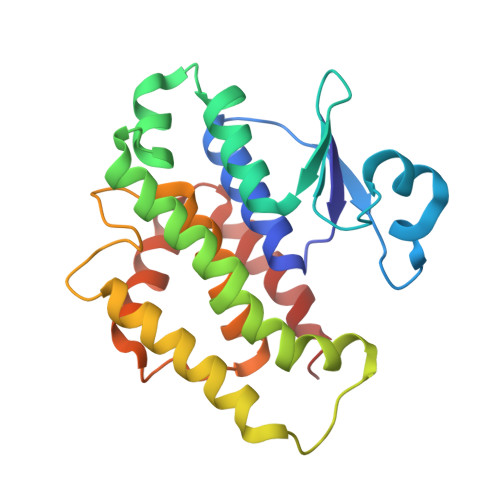Structural contributions of delta class glutathione transferase active-site residues to catalysis
Wongsantichon, J., Robinson, R.C., Ketterman, A.J.(2010) Biochem J 428: 25-32
- PubMed: 20196771
- DOI: https://doi.org/10.1042/BJ20091939
- Primary Citation of Related Structures:
3F63, 3F6D, 3G7J - PubMed Abstract:
GST (glutathione transferase) is a dimeric enzyme recognized for biotransformation of xenobiotics and endogenous toxic compounds. In the present study, residues forming the hydrophobic substrate-binding site (H-site) of a Delta class enzyme were investigated in detail for the first time by site-directed mutagenesis and crystallographic studies. Enzyme kinetics reveal that Tyr111 indirectly stabilizes GSH binding, Tyr119 modulates hydrophobic substrate binding and Phe123 indirectly modulates catalysis. Mutations at Tyr111 and Phe123 also showed evidence for positive co-operativity for GSH and 1-chloro-2,4-dinitrobenzene respectively, strongly suggesting a role for these residues in manipulating subunit-subunit communication. In the present paper we report crystal structures of the wild-type enzyme, and two mutants, in complex with S-hexylglutathione. This study has identified an aromatic 'zipper' in the H-site contributing a network of aromatic pi-pi interactions. Several residues of the cluster directly interact with the hydrophobic substrate, whereas others indirectly maintain conformational stability of the dimeric structure through the C-terminal domain (domain II). The Y119E mutant structure shows major main-chain rearrangement of domain II. This reorganization is moderated through the 'zipper' that contributes to the H-site remodelling, thus illustrating a role in co-substrate binding modulation. The F123A structure shows molecular rearrangement of the H-site in one subunit, but not the other, explaining weakened hydrophobic substrate binding and kinetic co-operativity effects of Phe123 mutations. The three crystal structures provide comprehensive evidence of the aromatic 'zipper' residues having an impact upon protein stability, catalysis and specificity. Consequently, 'zipper' residues appear to modulate and co-ordinate substrate processing through permissive flexing.
Organizational Affiliation:
Institute of Molecular Biosciences, Mahidol University, Salaya Campus, Nakhon Pathom, 73170, Thailand.















